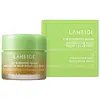What's inside
What's inside
 Key Ingredients
Key Ingredients

 Benefits
Benefits

 Concerns
Concerns

 Ingredients Side-by-side
Ingredients Side-by-side

Hydrogenated Polyisobutene
EmollientPhytosteryl/Isostearyl/Cetyl/Stearyl/Behenyl Dimer Dilinoleate
Skin ConditioningHydrogenated Poly(C6-14 Olefin)
EmollientDiisostearyl Malate
EmollientPolybutene
Phytosteryl Isostearyl Dimer Dilinoleate
EmollientMicrocrystalline Wax
Emulsion StabilisingButyrospermum Parkii Butter
Skin ConditioningSucrose Tetrastearate Triacetate
EmollientEthylene/Propylene/Styrene Copolymer
Synthetic Wax
AbrasiveMica
Cosmetic ColorantEuphorbia Cerifera Wax
Astrocaryum Murumuru Seed Butter
EmollientParfum
MaskingCandelilla Wax Esters
Dimethicone
EmollientDehydroacetic Acid
PreservativeCI 77891
Cosmetic ColorantButylene/Ethylene/Styrene Copolymer
Methicone
EmollientPolyglyceryl-2 Triisostearate
EmulsifyingCopernicia Cerifera Wax
Limonene
PerfumingPentaerythrityl Tetra-Di-T-Butyl Hydroxyhydrocinnamate
AntioxidantLinalool
PerfumingTocopherol
AntioxidantBHT
AntioxidantHydrogenated Polyisobutene, Phytosteryl/Isostearyl/Cetyl/Stearyl/Behenyl Dimer Dilinoleate, Hydrogenated Poly(C6-14 Olefin), Diisostearyl Malate, Polybutene, Phytosteryl Isostearyl Dimer Dilinoleate, Microcrystalline Wax, Butyrospermum Parkii Butter, Sucrose Tetrastearate Triacetate, Ethylene/Propylene/Styrene Copolymer, Synthetic Wax, Mica, Euphorbia Cerifera Wax, Astrocaryum Murumuru Seed Butter, Parfum, Candelilla Wax Esters, Dimethicone, Dehydroacetic Acid, CI 77891, Butylene/Ethylene/Styrene Copolymer, Methicone, Polyglyceryl-2 Triisostearate, Copernicia Cerifera Wax, Limonene, Pentaerythrityl Tetra-Di-T-Butyl Hydroxyhydrocinnamate, Linalool, Tocopherol, BHT
Diisostearyl Malate
EmollientPentaerythrityl Tetraisostearate
EmollientBis-Diglyceryl Polyacyladipate-2
EmollientPolybutene
Microcrystalline Wax
Emulsion StabilisingPolyglyceryl-2 Triisostearate
EmulsifyingButyrospermum Parkii Butter
Skin ConditioningIsostearyl Isostearate
EmollientHydrogenated Polyisobutene
EmollientTocopheryl Acetate
AntioxidantHelianthus Annuus Seed Oil
EmollientArgania Spinosa Kernel Oil
EmollientLavandula Angustifolia Oil
MaskingPhenoxyethanol
PreservativeCaprylyl Glycol
EmollientEthylhexylglycerin
Skin ConditioningPentaerythrityl Tetra-Di-T-Butyl Hydroxyhydrocinnamate
AntioxidantCI 45410
Cosmetic ColorantTitanium Dioxide
Cosmetic ColorantCI 77891
Cosmetic ColorantAluminum Hydroxide
EmollientBlue 1 Lake
Cosmetic ColorantCI 42090
Cosmetic ColorantTocopherol
AntioxidantAlumina
AbrasiveDiisostearyl Malate, Pentaerythrityl Tetraisostearate, Bis-Diglyceryl Polyacyladipate-2, Polybutene, Microcrystalline Wax, Polyglyceryl-2 Triisostearate, Butyrospermum Parkii Butter, Isostearyl Isostearate, Hydrogenated Polyisobutene, Tocopheryl Acetate, Helianthus Annuus Seed Oil, Argania Spinosa Kernel Oil, Lavandula Angustifolia Oil, Phenoxyethanol, Caprylyl Glycol, Ethylhexylglycerin, Pentaerythrityl Tetra-Di-T-Butyl Hydroxyhydrocinnamate, CI 45410, Titanium Dioxide, CI 77891, Aluminum Hydroxide, Blue 1 Lake, CI 42090, Tocopherol, Alumina
 Reviews
Reviews

Ingredients Explained
These ingredients are found in both products.
Ingredients higher up in an ingredient list are typically present in a larger amount.
This ingredient is also known as shea butter. It is an effective skin hydrator and emollient.
Emollients help soothe and soften your skin. It does this by creating a protective film on your skin. This barrier helps trap moisture and keeps your skin hydrated. Emollients may be effective at treating dry or itchy skin.
Shea butter is rich in antioxidants. Antioxidants help fight free-radicals, or molecules that may harm the body. It is also full of fatty acids including stearic acid and linoleic acid. These acids help replenish the skin and keep skin moisturized.
While Shea Butter has an SPF rating of about 3-4, it is not a sunscreen replacement.
Shea butter may not be fungal acne safe. We recommend speaking with a professional if you have any concerns.
Learn more about Butyrospermum Parkii ButterCi 77891 is a white pigment from Titanium dioxide. It is naturally found in minerals such as rutile and ilmenite.
It's main function is to add a white color to cosmetics. It can also be mixed with other colors to create different shades.
Ci 77891 is commonly found in sunscreens due to its ability to block UV rays.
Learn more about CI 77891Diisostearyl Malate is an emollient and most often used in lip products. It comes from isostearyl alcohol, a fatty acid, and malic acid, an AHA.
As an emollient, Diisostearyl Malate helps create a thin film on your skin to trap moisture in. This helps keep your skin soft and smooth.
Hydrogenated Polyisobutene is a synthetic polymer. Polymers are compounds with high molecular weight. Hydrogenated Polyisobutene is an emollient and texture enhancer.
In one study, Hydrogenated Polyisobutene showed better skin hydration levels than Caprylic/Capric Triglyceride. As an emollient, it helps keep your skin soft and hydrated by trapping moisture in.
Hydrogenated Polyisobutene is often used as a mineral oil replacement.
Learn more about Hydrogenated PolyisobuteneMicrocrystalline Wax is created by de-oiling petroleum. It is highly refined and purified before being added to cosmetics.
Microcrystalline Wax is used to enhance the texture and create even consistency. It helps stabilize a product by preventing ingredients from separating.
Pentaerythrityl Tetra-Di-T-Butyl Hydroxyhydrocinnamate (long name, huh?) is a synthetic antioxidant.
It is used to help stabilize other antioxidants or prevent the color from changing in a product.
As an antioxidant, it helps fight free-radical molecules. Free-radical molecules are capable of damaging our cells and other genetic material. Thus, antioxidants may reduce the signs of aging.
This ingredient is oil-soluble.
Learn more about Pentaerythrityl Tetra-Di-T-Butyl HydroxyhydrocinnamatePolybutene is used to help control the viscosity of a product. This just means it helps adjusts the texture.
It is a polymer and does not get absorbed into the skin due to its large size.
Studies found this ingredient did not irritate skin in concentrations below 15%.
Learn more about PolybuteneThis ingredient is a form of glycerin with emulsifying and emollient properties.
As an emulsifier, this ingredient helps keep products together while adding a thick texture. The manufacturer states this ingredient has emollient properties. Emollients help keep the skin hydrated by trapping moisture in.
Polyglyceryl-2 Triisostearate is created by reacting diglycerin and isostearic acid. Due to the isostearic acid base, it may not be safe for Malassezia or fungal acne.
Learn more about Polyglyceryl-2 TriisostearateTocopherol (also known as Vitamin E) is a common antioxidant used to help protect the skin from free-radicals and strengthen the skin barrier. It's also fat soluble - this means our skin is great at absorbing it.
Vitamin E also helps keep your natural skin lipids healthy. Your lipid skin barrier naturally consists of lipids, ceramides, and fatty acids. Vitamin E offers extra protection for your skin’s lipid barrier, keeping your skin healthy and nourished.
Another benefit is a bit of UV protection. Vitamin E helps reduce the damage caused by UVB rays. (It should not replace your sunscreen). Combining it with Vitamin C can decrease sunburned cells and hyperpigmentation after UV exposure.
You might have noticed Vitamin E + C often paired together. This is because it is great at stabilizing Vitamin C. Using the two together helps increase the effectiveness of both ingredients.
There are often claims that Vitamin E can reduce/prevent scarring, but these claims haven't been confirmed by scientific research.
Learn more about Tocopherol